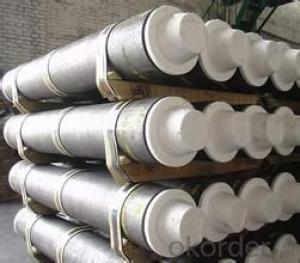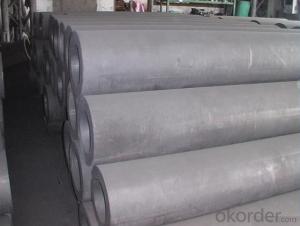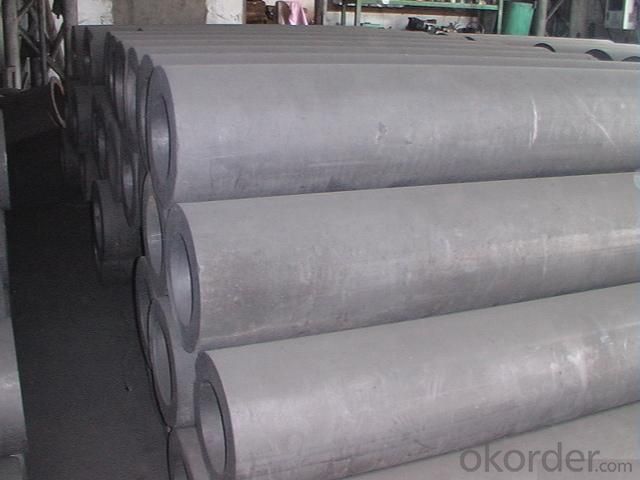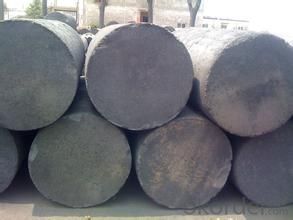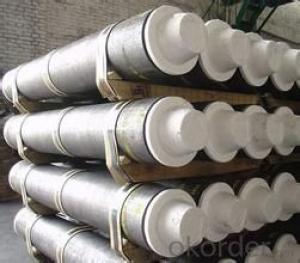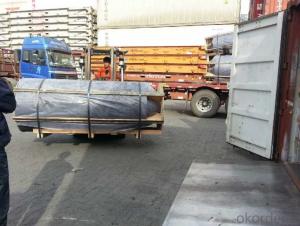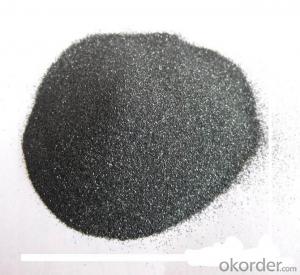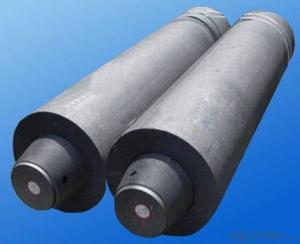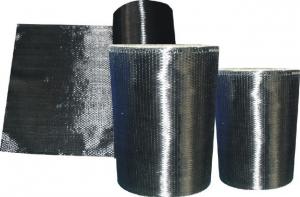Carbon Electrode for Silicon Metal Production
- Loading Port:
- Tianjin
- Payment Terms:
- TT OR LC
- Min Order Qty:
- 20 m.t.
- Supply Capability:
- 800 m.t./month
OKorder Service Pledge
OKorder Financial Service
You Might Also Like
Spcifications
1:carbon eletrode
2:for ferroalloy,calcium carbide, silicon metal, manufacture
Product Description
Carbon Electrode is abaked electrode used in submerged arc furnaces for delivering power to the charge mix. Electrode is added to the top of the electrode column cylindrical form. Electrode is essentially a mix of Electrically Calcined Anthracite (ECA) or Calcined Petroleum Coke (CPC) with Coal Tar Pitch and is baked for weeks, it is widly used for ferroally productiong, silicon metal production etc.
Graphite/Carbon Electrode Paste Specification:
| PARAMETER UNIT GUARANTEE VALUE | ||||||
| Items | Φ500~Φ700 | Φ750~Φ960 | Φ1020~Φ1400 | |||
| Rs μΩ.m | ≤45 | ≤38 | ≤45 | ≤38 | ≤40 | |
| Bulk Desity g/cm3 | ≥1.55 | ≥1.58 | ≥1.55 | ≥1.58 | ≥1.55 | ≥1.58 |
| Bending Strength MPa | 3.5~7.5 | 4.0~7.5 | 3.5~7.5 | 4.0~7.5 | 3.5~7.5 | 4.0~7.5 |
| Compressive Strength MPa | ≥20.0 | ≥20.0 | ≥20.0 | ≥20.0 | ≥19.0 | ≥19.0 |
| Compressive Strength MPa | 3.2~4.8 | 3.0~4.6 | 3.2~4.8 | 3.0~4.6 | 3.2~4.8 | 3.0~4.6 |
| Ash % | ≤2.5 | ≤2.0 | ≤2.5 | ≤2.0 | ≤2.5 | ≤2.0 |
Picture:
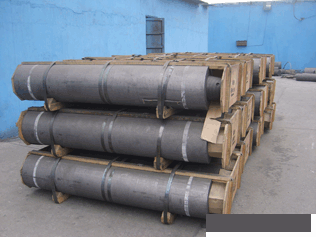
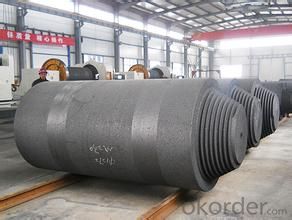
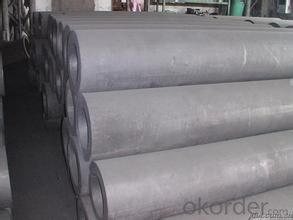

We Also supply all kind of carbon electrode paste and below materials, please contact us if you have any enquiry about it.
Calcined Anthracite
Calcined Petroleum Coke
Coke (Met Coke, Foundry Coke, Semi Coke)
Company information:
China National Building Materials Group is a stated -owned enterprise in charge of administrative affairs in China buiding materials industry.Established in 1984 CNBM is a large group corporation of building materials with total assets of 25 billion and a total stuff of 30000 CNBM now owns 200 subordinating firms of solely owned and joint-venture companies.
- Q: What is carbon emission and what harm does it do? How can carbon dioxide be prevented?
- The thermodynamic partial oxidation to synthesis gas, there is a relationship between O2 and CH4 mole ratio on deposition temperature, in the actual production is done, according to raw materials the ratio of the different temperature conditions of the appropriate choice, or according to the different ratio of raw materials, select the appropriate reaction temperature, to minimize coking of the catalyst.According to the metal partial oxidation of methane to Syngas in the catalyst, at different temperatures of pure CH4 and CO in nickel catalyst coke rate, found under the temperature of 1123K, 2CO is CO2+C rate than methane dissociation rates were slow 20 times and 5 times, which indicates that the catalytic pyrolysis of methane is the main way to deposit formation.
- Q: How are carbon markets regulated?
- Carbon markets are regulated through a combination of international agreements, national legislation, and the oversight of regulatory bodies. These regulations aim to ensure the transparency, integrity, and effectiveness of carbon trading activities. They often include requirements for the accurate measurement and reporting of emissions, the establishment of reliable registries, the accreditation of market participants, and the enforcement of compliance mechanisms.
- Q: What is the role of carbonation in carbonated drinks?
- The role of carbonation in carbonated drinks is to create the fizzy sensation and enhance the overall taste and mouthfeel of the beverage. It adds a refreshing and bubbly texture, making the drink more enjoyable to consume.
- Q: What are carbon offsets?
- Carbon offsets are a mechanism used to help reduce greenhouse gas emissions and combat climate change. They are essentially a way for individuals, organizations, or businesses to compensate for their own carbon dioxide (CO2) emissions by investing in projects that reduce emissions elsewhere. The concept behind carbon offsets is based on the understanding that emissions reduction can be achieved in various ways and at different costs. Instead of solely focusing on reducing their own emissions, carbon offsetting enables individuals or entities to support projects that can achieve greater emission reductions per unit of cost. These projects can include renewable energy, energy efficiency, reforestation, and methane capture, among others. To acquire carbon offsets, individuals or organizations typically calculate their own carbon footprint by assessing the amount of CO2 they emit through their activities, such as energy consumption or transportation. After quantifying their emissions, they can purchase carbon offsets equivalent to the amount of CO2 they have emitted. These offsets are generated by projects that are independently verified and certified by recognized standards and registries. Once the carbon offsets are purchased, they are effectively canceled or retired, ensuring that the emissions reduction achieved by the project is not double-counted or claimed by someone else. By investing in carbon offsets, individuals or organizations can effectively neutralize their own emissions and contribute to global efforts to address climate change. However, it is important to note that carbon offsets should not be seen as a substitute for reducing emissions at the source. They should be used as a complementary tool to support emission reduction efforts, while simultaneously implementing measures to minimize our own emissions through energy efficiency, renewable energy adoption, and sustainable practices.
- Q: How does carbon impact the growth and development of plants?
- Carbon is an essential element for the growth and development of plants. It plays a crucial role in the process of photosynthesis, which is how plants convert sunlight into energy. During photosynthesis, plants absorb carbon dioxide from the atmosphere and use it, along with water, to produce glucose and oxygen. Glucose is the primary source of energy for plant growth and is utilized to build various molecules such as cellulose, proteins, and lipids. In addition to being a key component of sugars, carbon is also a vital element in the structure of plant cells. It forms the backbone of complex organic compounds, including carbohydrates, proteins, nucleic acids, and lipids. These compounds are essential for the growth and development of plants, as they are involved in processes like cell division, cell elongation, and the formation of new tissues. Furthermore, carbon is involved in regulating various physiological and metabolic processes in plants. It influences the opening and closing of stomata, the tiny pores on the surface of leaves, which control the uptake of carbon dioxide and the release of oxygen and water vapor. Carbon also affects the production of plant hormones, which are responsible for regulating growth, development, and responses to environmental stimuli. However, excessive carbon dioxide in the atmosphere, resulting from human activities such as burning fossil fuels, can have negative impacts on plants. Elevated levels of carbon dioxide can lead to changes in plant physiology, including increased photosynthesis rates and decreased stomatal conductance. These changes can affect the nutritional quality of plants, alter their interactions with pests and diseases, and disrupt ecosystems. In summary, carbon is essential for the growth and development of plants as it is a key component of sugars, organic compounds, and structural elements in plant cells. It is involved in processes such as photosynthesis, cell division, and the regulation of physiological and metabolic functions. However, changes in atmospheric carbon dioxide levels can have both positive and negative impacts on plants, emphasizing the need for sustainable practices to ensure the future growth and development of plant species.
- Q: What kind of industry does high-performance carbon fiber belong to?
- High performance carbon fiber is used in many industries, such as automobiles, bicycles, and even the aviation industry.. If you look at the industry type, many industries have high-performance carbon fiber figure, if divided by the industry attributes, should belong to the emerging industry, the future potential of the industry
- Q: How does carbon impact the formation of smog?
- Carbon plays a significant role in the formation of smog as it is one of the main contributors to the formation of ground-level ozone. When carbon-based pollutants, such as vehicle exhaust and industrial emissions, react with sunlight and other pollutants in the atmosphere, they undergo a complex chemical reaction leading to the production of smog. This smog not only poses health risks to humans but also harms the environment by contributing to climate change and damaging ecosystems.
- Q: What are the different types of carbon-based food additives?
- The food industry commonly utilizes various carbon-based food additives for different purposes. These additives have multiple functions, including enhancing flavor, improving texture, and extending the shelf life of food products. Here are a few examples: 1. Activated Carbon: Used as a food coloring agent, activated carbon is a porous form of carbon with high adsorption properties. It is often employed to give black color to specific food and beverages, such as black food coloring or black lemonade. 2. Carbon Black: Also known as vegetable carbon or vegetable black, this additive is derived from charcoal and serves as a natural food coloring agent. It is frequently utilized to provide a dark black or grey color to foods like black licorice, ice cream, and bakery products. 3. Carbon Dioxide: Though not directly added as an additive, carbon dioxide gas is utilized in food processing and packaging to prolong the shelf life of certain products. It is commonly present in carbonated beverages to create the characteristic fizz and is also used in modified atmosphere packaging to preserve the freshness of specific foods. 4. Carbonated Water: This refers to carbon dioxide gas dissolved in water, resulting in carbonic acid. Carbonated water is often used as a base for soft drinks and beverages, imparting effervescence and a refreshing taste. 5. Carbonates: Calcium carbonate and sodium carbonate are examples of carbonates used as acidity regulators in food products. They aid in maintaining the pH balance and controlling the acidity of certain foods, such as canned vegetables, fruit preserves, and pickles. 6. Carbon-based Preservatives: Sorbic acid and propionic acid, among other carbon-based additives, act as preservatives to prevent the growth of molds, bacteria, and yeasts in food products. They contribute to extending the shelf life of products like bread, cheese, and processed meats. It is essential to note that while carbon-based food additives are generally considered safe for consumption, it is advisable to read food labels and seek guidance from professionals, such as dietitians or healthcare providers, if any concerns or specific dietary restrictions arise.
- Q: What is carbon neutral construction?
- Carbon neutral construction refers to a sustainable approach to building and designing structures that minimizes or offsets the amount of carbon emissions produced during the construction process. It aims to achieve a balance between the amount of carbon emissions released into the atmosphere and the amount that is removed or offset through various measures. To achieve carbon neutrality in construction, several strategies can be implemented. Firstly, energy-efficient design principles are employed to minimize the overall energy consumption of the building. This can include the use of insulation, efficient HVAC systems, and energy-efficient appliances and lighting. Additionally, sustainable building materials are utilized, such as recycled materials or those with a low carbon footprint. This reduces the energy required for the production and transportation of materials, thereby minimizing carbon emissions. Furthermore, renewable energy sources are integrated into the construction process. This may involve installing solar panels, wind turbines, or geothermal systems to generate clean energy for the building's operations. By reducing dependence on fossil fuels, carbon emissions associated with energy consumption are significantly reduced. Carbon offsetting is another key component of carbon neutral construction. This involves investing in projects or initiatives that reduce or remove greenhouse gas emissions elsewhere, effectively offsetting the emissions produced during construction. Examples of carbon offsetting activities include reforestation projects, investment in renewable energy projects, or supporting methane capture initiatives. Ultimately, carbon neutral construction aims to reduce the environmental impact of building construction and operation by minimizing carbon emissions throughout the entire lifecycle of the building. By adopting energy-efficient design principles, utilizing sustainable materials, integrating renewable energy sources, and offsetting carbon emissions, carbon neutral construction contributes to mitigating climate change and creating a more sustainable future.
- Q: What are the effects of carbon emissions on the stability of desertification?
- Carbon emissions contribute to the stability of desertification by exacerbating its effects. Increased atmospheric carbon dioxide levels lead to global warming, which in turn intensifies droughts and reduces precipitation in arid regions. This prolonged dryness accelerates soil degradation, reduces vegetation cover, and undermines the ability of arid ecosystems to sustain life. Therefore, carbon emissions play a significant role in destabilizing desertification processes and further threatening the stability of arid landscapes.
Send your message to us
Carbon Electrode for Silicon Metal Production
- Loading Port:
- Tianjin
- Payment Terms:
- TT OR LC
- Min Order Qty:
- 20 m.t.
- Supply Capability:
- 800 m.t./month
OKorder Service Pledge
OKorder Financial Service
Similar products
Hot products
Hot Searches
